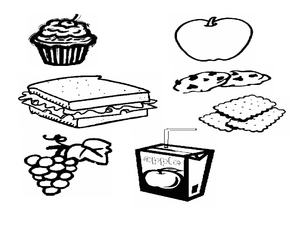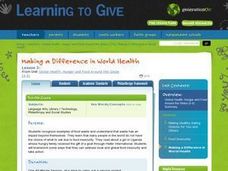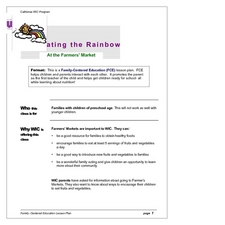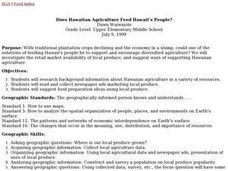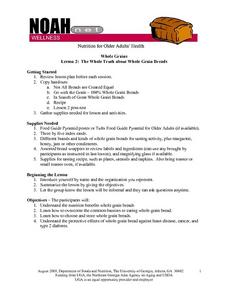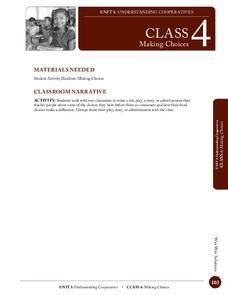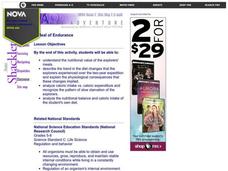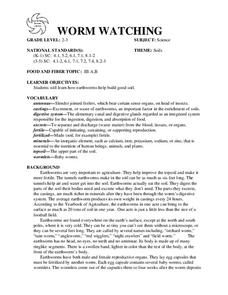Curated OER
Yummy Math
Young mathematicians use bags of Skittles to help them gain practice in graphing and organizing data. They work in pairs, and after they have counted and organized their Skittles, they access a computer program which allows them to print...
Curated OER
Where's Dinner?
Upcoming marine biologists consider a list of organisms residing near the Lost City hydrothermal vents and construct a food web. They compare the food web to that of a cold seep community, of which they should have previous knowledge....
Curated OER
Good Enough To Eat
Students are introduced to the five food groups. In groups, they place different foods into the correct section of the Food Pyramid. Using different types of technology, they create one page of a class ABC book sharing what they know...
Curated OER
Engineering and the Senses
Learners explore nutrition. For this nutrition lesson, students discuss a person's sense of taste and how it is different for each person. Learners discuss favorite foods and how they relate to nutrition. Students cut out pictures of...
Curated OER
Fresh Greens In The Home
Students engage in the study of nutritional food choices that include fresh greens. They investigate the benefits of using simple planting techniques. The lesson also includes recipes for students to try out the habit of eating more food...
Curated OER
Minerals
Pupils compare the two main groups of minerals. For this nutritional lesson, students learn which foods contain the best source of minerals needed to maintain good health. They study the minerals that are required to be on the...
Curated OER
Health and Growth
Students identify healthy foods. In this nutrition instructional activity, students review the five food groups and categorize healthy and unhealthy foods on a chart. Students develop their own menus.
Curated OER
Making a Difference in World Health
Students discover environmental awareness by conducting a collection project in class. In this global food lesson, students identify the importance of feeding all of the humans on Earth and discuss why some aren't properly nourished....
Curated OER
Secrets of the Ocean Realm - Survival in the Sea
Students determine the sequential links in a marine food chain and identify the roles that various organisms play in this chain. Students develop charts as visual aids for illustrating marine food chains.
Curated OER
Eating the Rainbow: At the Farmer's Market
Students share what type of fruit and vegetables they like. In this adult health lesson, students explain the benefits of eating healthy foods. They discuss recipe ideas that can be done at home.
Curated OER
Math Nutrition
Fifth graders use nutritional knowledge to plan balanced meals and use grocery store flyers to calculate costs of the meals. They create word problems using these flyers.
University of Georgia
The Power of Peanuts
Measure the amount of energy in a peanut by igniting a chemical reaction. Classes use a laboratory setup to burn a peanut and measure the amount of heat it releases through a temperature analysis. They calculate the number of Joules of...
Curated OER
Testing for Life’s Molecules
Want to hear a joke about sodium? Na. Young scientists test various materials to identify if they include protein, starch, and glucose by using the Biuret test, iodine starch test, and Benedict's test respectively. After practicing with...
Curated OER
Does Hawaiian Agriculture Feed Hawaii's People?
Students research background information about Hawaiian agriculture in a variety of resources, then read and collect newspaper ads marketing local produce. They suggest food preparation ideas using local produce.
Curated OER
Comparing-Contrasting With Cookies
Students compare and contrast cookies. In this compare and contrast lesson plan, students complete a graphic organizer and identify the similarities and differences in Girl Scout Cookies. Students write an analysis.
Curated OER
The Whole Trut about Whole Grain Breads
Students comprehend the nutrition benefits whole grain breads. They explore how to overcome the common barriers to eating whole grain bread. Students investigate how to choose and store whole grain breads. They comprehend the...
Curated OER
Where's the Beef - Beef Facts or Hype, Is it Bad for You?
Analyze a Happy Meal™ for nutrient content and calories. Blend the contents into "McMush" and use Biuret's solution to test for protein content. There are a few problems with the lesson plan: the resource links are no longer...
Captain Planet Foundation
George Washington Carver and the Sweet Potato
Learn about George Washington Carver's important contributions to agriculture by studying the sweet potato. First graders read about the inventor's observations and prepare sweet potato slips for the class garden. Additionally, they...
Curated OER
Coral Reefs Endangered
Students research where in the world coral reefs are located. In this ecology instructional activity, students create food chains and food web. They simulate growing coral reefs to understand their characteristics better.
Curated OER
Making Choices
Students work with a partner to write a play, story or ad that teaches about our choices as consumers. Students focus on educating people about how food choices make a difference in their lives.
Curated OER
A Meal of Endurance
Students examine the importance of the nutritional value of explorers' meals. They investigate the concepts of caloric intake vs. caloric expenditure and examine their own nutrition.
Curated OER
Trophic Ecology of Humans
students analyze the place of humans among the tropic levels by observing what we eat. They calculate the caloric content of several foods commonly eaten by humans and calculate the total energy cost to grow, process, transport, store...
Curated OER
Trophic Ecology of Humans
Students analyze the trophic level of humans by first calculating the kilocalories in own their lunch. They then calulate the kilocalories in a wide variety of foods found in grocery stores and compare the kilocalories needed to acquire...
Curated OER
WORM WATCHING
Students investigate how earthworms help build good soil. They examine the worms carefully to find the ringlike segments and swollen band at the front of the earthworm's body. Students take turns dampening the soil every day and adding...





